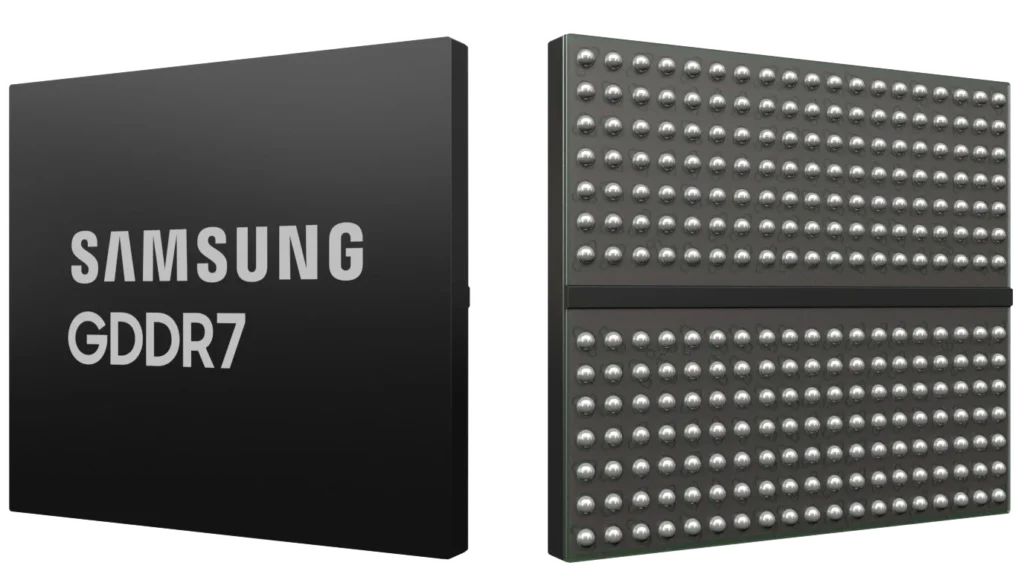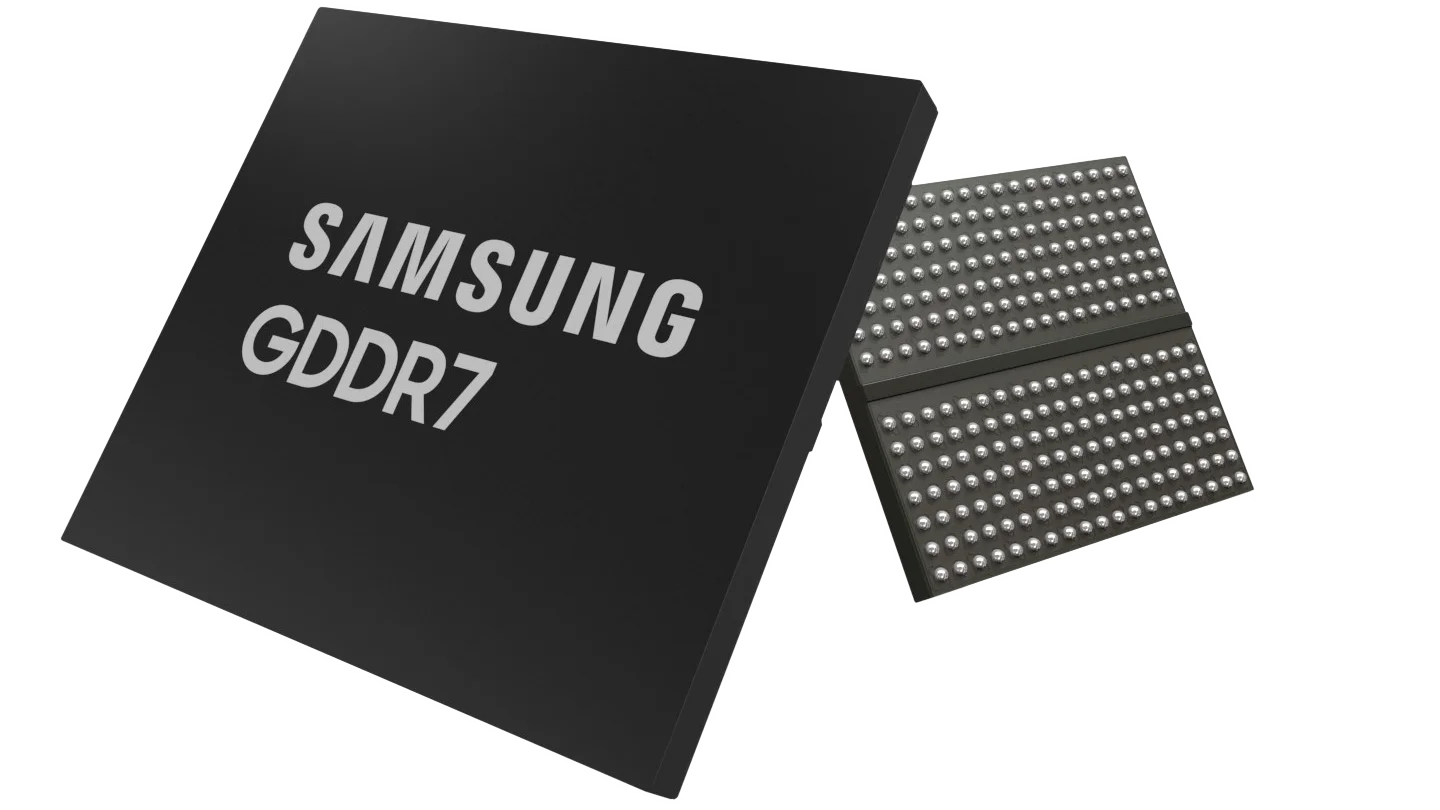Samsung has announced the development industry’s first GDDR7 graphics card VRAM. It’s likely that it will be used in the Nvidia RTX 5000 and AMD RX 8000 series.
Every computing device one uses requires some sort of RAM chip to function. From computers to mobile devices to even routers. All of them require different types of RAM.
Such is also the case with graphics cards. They require a special type of VRAM, called GDDR. Debuting preliminarily with GDDR3, the latest versions of graphics card VRAM are GDDR6 and its improved version, GDDR6X.
In memory chip manufacturing, there are three major manufacturers. Micron, SK Hynix and Samsung. Samsung is the largest in terms of sales and revenue.
A few days ago, we reported how Micron announced that it expects GDDR7 to be available by first half of 2024. Meanwhile, it seems that Samsung has developed its first GDDR7 chips.
Samsung Develops GDDR7

In a news release, Samsung has announced (via @harukaze5719) the development of the industry’s first GDDR7 VRAM chips. In it, it is announced that these chips will run at 32Gbps, which is double of what GDDR6 debuted at.
Additionally, Samsung states that compared to the current 24Gbps GDDR6, the GDDR7 chip by them has a 20% improvement in power efficiency and 1.4 times the boost in performance.
These chips will be available in 16Gb (2GB) capacities. Which is slightly disappointing as everyone wants and expects newer VRAM chips to be available in 4GB versions at least, allowing more VRAM in graphics cards. For the record, graphics cards have multiple VRAM chips on them. The larger the chip capacity, the more VRAM a graphics card can theoretically come with.
In terms of raw performance, Samsung describes that its GDDR7 offering achieves a bandwidth of 1.5TBps at 32Gbps per pin, which is, as claimed above, 1.4 times higher than the 1.1TBps found in GDDR6.
To do that, Samsung says it uses the new PAM3 signaling method. This is different from the NRZ used in GDDR6. Samsung claims, “PAM3 allows 50% more data to be transmitted than NRZ within the same signaling cycle.”
To reduce heat generation, Samsung is using an epoxy molding compound with high thermal conductivity in the packaging of these chips, in addition to architectural improvements. Samsung says that doing this has reduced the thermal resistance by 70% when compared to GDDR6.
Technicalities Explained

The announcement is very good. But it lacks clarity in some things.
First, while Samsung says it will start providing them for installation to key customers, it doesn’t mention when they will be mass-produced. What we do expect is that next-gen graphics cards like the Nvidia RTX 5000 and AMD RX 8000 might use these GDDR7 chips. It’s important to mention that the Nvidia RTX 5000 series is going to be delayed. This means it’s highly likely to use GDRR7 instead of GDDR6X it currently uses.
The second thing is that Tom’s Hardware mentions that better efficiency doesn’t mean these chips will use less power. Instead, it could suggest that they will deliver more performance when compared with their power usage.
Tom’s Hardware also argues that as Samsung is using epoxy molding compound in the packaging of these chips, it means that extra effort is being required to control their heat generation.
It is said that the PAM3 signaling method is more complex and requires more power, which translates into more heat generation. However, it must be mentioned that GDDR6X, used by Nvidia in its RTX 40 series, uses the PAM4 signaling method, which is more powerful but less efficient than the PAM3 used in GDDR7.
Another thing worth pointing out is that @RyanSmithAT on Twitter (login possibly required) noticed that these GDDR7 chips use 266 pins, which is 86 (48%) more than the ones found in GDDR6 and GDDR6X. Which can cause minor issues for board makers.
More Technicalities
While writing this article, we came across more information shared by @RyanSmithAT on Twitter.
He has revealed that Samsung has replied to his questions about more technical details of GDDR7.
Samsung has responded to him with the same. GDDR7 is going to run at 1.2 volts, which is less than the 1.35 volts used in GDDR6. Which is great as it reduces power consumption and generates less heat.
The energy efficiency of GDDR7 at 32Gbps is lower when compared to GDDR6 at 24Gbps. Overall, it’s going to use 7% more power.
The process node in GDDR7 is going to be D1z (15.7nm), which is the same as the one found in GDDR6. Which he says means that the 20% improvement in energy efficiency is due to architectural improvements and not process node ones.
Overall, GDDR7 is very exciting. Let’s see how fast it performs in the real world and when it becomes available.



3175x175(CURRENT).thumb.jpg.b05acc060982b36f5891ba728e6d953c.jpg)
Recommended Comments
There are no comments to display.
Join the conversation
You can post now and register later. If you have an account, sign in now to post with your account.
Note: Your post will require moderator approval before it will be visible.